 Purdue University - Extension - Forestry and Natural Resources
Purdue University - Extension - Forestry and Natural Resources
Got Nature? Blog
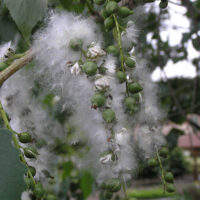 Populus deltoides, more commonly known as the Eastern cottonwood, becomes a topic of conversation & complaint every year around this time. A member of the willow family, this tree is found along rivers, roads, in parks, and around residential areas. It grows to heights of 75 to 100 feet spanning up to 75 feet wide. It prefers moist to wet well-drained soils but tolerates many types of sites. Cottonwoods also produce small seeds with a tuft of cotton fluff (to assist with dispersal) that can number in the millions for a single tree.
Populus deltoides, more commonly known as the Eastern cottonwood, becomes a topic of conversation & complaint every year around this time. A member of the willow family, this tree is found along rivers, roads, in parks, and around residential areas. It grows to heights of 75 to 100 feet spanning up to 75 feet wide. It prefers moist to wet well-drained soils but tolerates many types of sites. Cottonwoods also produce small seeds with a tuft of cotton fluff (to assist with dispersal) that can number in the millions for a single tree.
That’s right, we are in the season of the cottonwood seed. You may be walking or driving around or just looking out your window and it can look like winter is trying to attack with one last blizzard before summer sets in. Seed production occurs between May and June for about 2 weeks with the floating cotton balls accumulating on roads and paths, in yards and parks, and in other locations with a little bit of grab. Seedlings easily germinate, but are delicate, and in urban areas with an abundance of lawn care, many do not survive or are killed by excessive heat or rain.
Many concerns that I hear about are clogging of waterways or air filters, and the worry of fires. Seeds usually flow easily downstream without the volume or mass to clog waterways. They can accumulate on air conditioner units or other filters but are easily cleaned off. Cottonwood seeds are highly flammable, can pose a risk in drier climates, and should not be ignited to clean them up. They can be cleaned like leaves with fine-tined rakes or picked up in clusters and bagged. The good news is this usually only lasts for about 2 weeks.
If you do have any questions about managing your cottonwood trees, feel free to contact your local extension office or you can search for ISA-certified arborists in your area at Find an Arborist.
Resources:
ID That Tree, Playlist, Purdue Extension – FNR YouTube Channel (Invasive White Mulberry, Siberian Elm, Tree of Heaven)
Eastern Cottonwood, Article, Purdue Fort Wayne
Find an Arborist video, Trees are Good-International Society of Arboriculture (ISA)
A Woodland Management Moment, Playlist, Purdue Extension – FNR YouTube Channel (Against Invasives, Garlic Mustard, Autumn Olive)
Woodland Stewardship for Landowners, Playlist, Purdue Extension – FNR YouTube Channel (Common Buckthorn, Japanese Barberry)
Trees and Storms – The Education Store, Purdue Education’s resource center
Planting Your Tree, Video, The Education Store
Tree Installation, The Education Store
Indiana Invasive Species Council
Indiana Department of Natural Resources: Invasive Species
Subscribe – Purdue Extension-FNR YouTube Channel
Ben McCallister, Urban Forestry Specialist
Purdue Forestry & Natural Resources
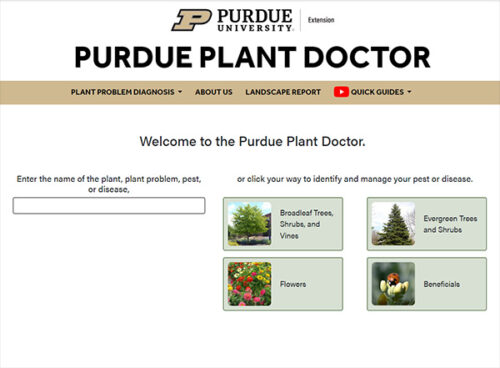 Purdue Extension News – Whitely County Posts: The recently launched Purdue Plant Doctor website at purdueplantdoctor.com navigates like a smartphone app and can help growers identify and manage insect pests and diseases of trees, shrubs, and flowers. It will also help growers recognize “good bugs,” those beneficial insects that prey on harmful insect pests or serve as valuable pollinators. Helpful instructional videos provide supplemental content.
Purdue Extension News – Whitely County Posts: The recently launched Purdue Plant Doctor website at purdueplantdoctor.com navigates like a smartphone app and can help growers identify and manage insect pests and diseases of trees, shrubs, and flowers. It will also help growers recognize “good bugs,” those beneficial insects that prey on harmful insect pests or serve as valuable pollinators. Helpful instructional videos provide supplemental content.
Purdue entomologist Cliff Sadof was a key contributor to this site. He said that identifying a plant problem is the first step to improving the health of plants in the landscape. “We created a series of short (5 to 7 min.) YouTube videos to help you learn or just brush up your plant diagnostic skills,” he said. “Each video guides you through the diagnostic process in real landscapes, reviews pest biology, and provides tips on management.” Videos finish with a demonstration of how to use the Purdue Plant Doctor to confirm your diagnosis and get current recommendations. Key moments tabs help you navigate through each video.
Users may watch these videos in English or Spanish from the “Quick Guides” available on the website or directly from YouTube. Some of the topics include:
- Diagnosing Plant Problems with the Purdue Plant Doctor Web Page: Learn how to diagnose and manage pest and disease problems on ornamental plants and how to keep your plants healthy. The Plant Doctor Web page is a mobile-ready website that can improve communication between plant care professionals and their clientele. Spanish version is also available.
- Beating Back Borers of Pines and Other Cone Bearing Trees with the Purdue Plant Doctor: Borers can be a real problem in landscapes that use pines and other evergreens to serve as a windbreak or a visual screen. Learn how to detect borer problems before they destroy your planting, and get tips on protecting these coniferous trees from borers. Spanish version is also available.
- Managing Spider Mite Mayhem with the Purdue Plant Doctor: Spider mites may be small, but they can cause big problems. Learn how to detect mites before they harm plants, and what you can do to keep plants healthy before and after mites have been detected. Spanish version is also available.
- All You Need to Know about Managing Scales and Mealybugs with the Purdue Plant Doctor: Drought and rising temperatures can make plants more susceptible to scale insects. Learn about the threats these insects pose to your plants and landscapes. Then find out how you can monitor them and improve your ability to keep your plants safe from harm. Spanish version is also available.
- Taming Aphid Problems with the Purdue Plant Doctor: Aphid problems can turn your landscape into a sticky mess. Learn the threats they pose to your plants and how to detect and manage them. Spanish version is also available.
- Managing Japanese Beetle with The Purdue Plant Doctor: Japanese beetles can wreak havoc in your landscape by consuming the flowers and leaves of your ornamental planting or by killing your turf. Learn why Japanese beetle traps can make Japanese beetle problems worse. Get the latest information about these beetles and how to control them. Spanish version is also available.
- Managing Plant Galls with the Purdue Plant Doctor: Galled about Galls? Want to learn how to diagnose bumps on plants and how they affect plants? This video will discuss the causes of plant galls and what you need to do to keep your plants healthy. Spanish version is also available.
Too often when we see an insect, we automatically think it’s a pest. But that is not always the case. The Purdue Plant Doctor website will also help you recognize beneficial insects like ambush bugs, assassin bugs, ground beetles, soldier beetles, lacewings, and minute pirate bugs.
So, whether you are a homeowner or a landscape professional, the Purdue Plant Doctor can help you manage pests in landscapes and recognize the beneficial insects in landscapes.
More Resources:
Hardwoods of the Central Midwest, Purdue Arboretum Explorer
Forest Improvement Handbook, The Education Store, Purdue Extension’s resource center
ID That Tree, Purdue Extension-Forestry & Natural Resources (FNR) YouTube playlist
Native Trees of the Midwest, The Education Store
Woodland Management Moment , Purdue Extension-FNR YouTube playlist
Tree Installation: Process and Practices, The Education Store, Purdue Extension’s resource center
Planting Your Tree Part 1: Choosing Your Tree, video, The Education Store
Tree Risk Management – The Education Store
Find an Arborist website, Trees are Good, International Society of Arboriculture (ISA)
John E. Woodmansee, Extension Educator – Agriculture and Natural Resources (ANR)
Purdue Extension – Whitely County
Wild Bulletin, Indiana Department of Natural Resources (DNR) Fish and Wildlife: The hunt may be over soon, but the fun isn’t. Now is the time to create memories with your bird. You can preserve many parts of your turkey, such as the fan, spurs, and beards, to remind you of the experience. Plus, the meat of the wild turkey is excellent and healthy.
Watch the videos on how to process your turkey on the Indiana DNR – Turkey Hunting YouTube playlist.
Subscribe to the Indiana Department of Natural Resources YouTube Channel.
Resources:
Truths and Myths about Wild Turkey, The Education Store, Purdue Extension resource center
Wildlife, Playlist, Purdue Extension – Forestry and Natural Resources (FNR) YouTube Channel
Managing Your Property for Fish & Wildlife, Ask an Expert. FNR YouTube Channel
Forest Improvement Handbook, The Education Store
Help With Wild Turkey Populations, Video, Purdue Extension – Forestry and Natural Resources YouTube Channel
Turkey Brood Reporting, Indiana Department of Natural Resources (IN DNR)
Wild Turkey, Indiana Department of Natural Resources (IN DNR)
Wild Turkey Hunting Biology and Management, Indian Department of Natural Resources (IN DNR)
Subscribe to Purdue Extension-Forestry & Natural Resources YouTube Channel, Wildlife Playlist
Indiana Department of Natural Resources – Division of Fish & Wildlife
Wild Bulletin, Indiana Department of Natural Resources (DNR) Fish and Wildlife: Paddling is a great way to enjoy Indiana’s natural beauty, observe wildlife, and connect with nature. Indiana paddlers have a unique opportunity to observe wildlife while enjoying Indiana’s countless water resources. Indiana DNR would like more information about the wildlife that spend time around Indiana’s waterways. The Indiana Paddlecraft Wildlife Index compiles wildlife observations from people who use canoes, kayaks, or other non-motorized paddlecraft on Indiana’s waterways. Volunteer paddlers can help by completing a paddling trip postcard documenting the wildlife they observed while floating from June 1 to July 31.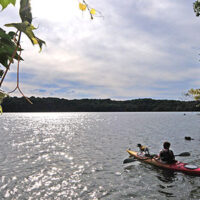
To find out more information, please visit the DNR website.
Resources:
Yellow Perch Farmed Fish Fact Sheet, The Education Store, Purdue Extension’s resource center
Rainbow Trout Farmed Fish Fact Sheet, The Education Store
American Paddlefish, The Education Store
Aquaculture Family Coloring Book Development, The Education Store
Eat Midwest Fish, Illinois-Indiana Sea Grant online resource hub
Protect Your Waters, U.S. Fish and Wildlife Service & U.S. Coast Guard
What are invasive species and why should I care?, Got Nature? Blog, Purdue Extension – Forestry and Natural Resources
Aquatic Invasive Species in the Great Lakes: The Quagga Mussel, Purdue Extension – Forestry & Natural Resources (FNR) Got Nature? Blog
Aquatic Invaders in the Marketplace, Illinois-Indiana Sea Grant (IISG)
Invasive Species, Playlist, Purdue Extension – FNR YouTube Channel
Nongame and Endangered Wildlife, Indiana Department of Natural Resources
Subscribe to Purdue Extension-FNR YouTube Channel
Indiana Department of Natural Resources, Department of Fish & Wildlife
Illinois-Indiana Sea Grant (IISG) has recently added to its YouTube Channel new water safety videos, which share what to watch for and how to stay out of those scary situations that can become dangerous very quickly.
Water Safety Basics: Water safety is more then just knowing how to swim. You need to what can cause hazards, what type of water bodies have hazards and how to avoid or survive those hazards.
Water Safety – What to Know Before You Go to the Beach: On average every year, 87 people die in the Great Lakes, half of them are in Lake Michigan. Ocean waves are very different from Great Lake waves.
Water Safety – Winter Beach Hazards: Water safety is so important during the winter. When covered in snow and ice, it’s difficult to tell where the beach ends and the lake begins. Shelf ice is beautiful but dangerous. There are many places where it cannot support a person’s weight, which may cause a fall into freezing water below, so you should never walk on shelf ice.
Water Safety – How to Escape Dangerous Currents: Of the five Great Lakes, Lake Michigan has the highest number of drownings and rescues each year. Lake Michigan is freshwater. This is so different from an ocean. It doesn’t have the salt, so it is lacking that buoyancy already. If waves get super high and rip currents start to form and that water gets volatile, it is going to be much harder to get out of the situation if you start struggling while you are swimming.
Water Safety – Southern Lake Michigan: Lake Michigan has also had more than 250 recorded cases of swimmers caught in rip currents since 2002, which is double the combined total of the other four Great Lakes. Make sure you check the forecast before you come and have a safety plan. In the ocean you can get hit by two waves in 15 seconds but in the Great Lakes you could get his with five waves in that same time period. Learn more about high frequency waves and how dangerous it can be.
Illinois-Indiana Sea Grant combines research, education, and outreach to empower southern Lake Michigan communities to secure a healthy environment and economy. The program is funded through National Oceanic and Atmospheric Administration (NOAA) via the National Sea Grant College Program, as well as the University of Illinois and Purdue University. IISG also works in partnerships with key organizations, institutions, and agencies in the region to reach more audiences and multiply opportunities for success. IISG brings together scientists, educators, policy makers, community decision makers, outreach specialists, business leaders, and the general public to work towards a healthy environment and economy.
Subscribe to the Illinois-Indiana Sea Grant (IISG) YouTube Channel.
More Resources:
Implementation Examples of Smart Growth Strategies in Indiana, The Education Store, Purdue Extension’s resource center
Conservation Through Community Leadership, The Education Store
Conservation Through Community Leadership, Sustainable Communities Extension Program (SCEP)
Conservation through Community Leadership, Purdue Extension You Tube Channel
Rainscaping Education Program, Purdue Extension
Rainscaping and Rain Gardens, Purdue Extension YouTube Channel
Tipping Point Planner, The Education Store
Tipping Point Planner, Purdue Agriculture YouTube Channel
Enhancing the Value of Public Spaces, The Education Store
Enhancing the Value of Public Spaces: Creating Healthy Communities, The Education Store
Enhancing the Value of Public Spaces Program, Purdue Extension YouTube Channel
One Water Approach to Water Resources Management, The Education Store
Community Development, Purdue Extension
Community Planning Playlist, Purdue Extension-Forestry & Natural Resources (FNR) YouTube Channel
Indiana Creek Watershed Project – Keys to Success, Partnerships and People, Subscribe to Purdue Extension-FNR YouTube Channel
Climate Change and Sustainable Development, The Education Store
Climate Change: Are you preparing for it?, The Education Store
Diana Evans, Extension & Web Communications Specialist
Purdue University Department of Forestry and Natural Resources
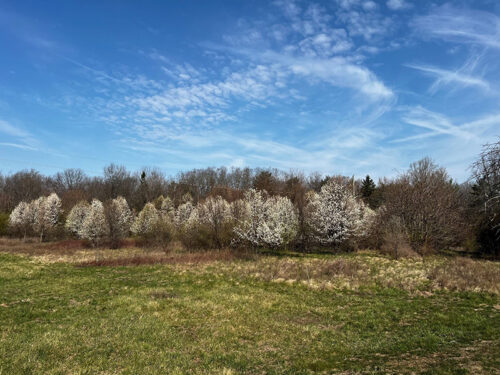 Purdue Landscape Report: Most people these days have, at the very least, heard of Callery and Bradford pear trees and know something about the invasiveness of this ornamental street tree. But I still get questions about what it is and why it’s so bad. So, I’d like to offer a little history of this infamous tree. Where did it come from, why is it so popular, why is it such an awful tree to plant, and some suggestions for better species to plant in its place.
Purdue Landscape Report: Most people these days have, at the very least, heard of Callery and Bradford pear trees and know something about the invasiveness of this ornamental street tree. But I still get questions about what it is and why it’s so bad. So, I’d like to offer a little history of this infamous tree. Where did it come from, why is it so popular, why is it such an awful tree to plant, and some suggestions for better species to plant in its place.
Pyrus calleryana, the Callery pear (Fig. 1), was originally introduced from Asia to the United States in 1908. This was done in an attempt to breed pear trees that were resistant to fire blight, a bacterial disease that can spread rapidly causing leaves and branches to blacken as if burnt by fire, eventually resulting in death. Along with its resistance, the Callery pear was tested as a rootstock for the edible European pear (Pyrus communis) and its vigor in growth.
Callery Pear grows to a height of 30 to 50 feet with a spread up to 30 feet wide. Thick leaves grow alternately, are dark green, grow with sharp spurs along branches, and turn reddish-purple in the fall. They are one of the first trees to bloom and begin to grow in the spring and one of the last to drop their leaves in the fall. They produce a beautiful show of white flowers in the spring that have an unfortunate odor and an abundance of small fruits in the fall that are spread by birds and other wildlife. In fact, invasive European Starlings are one of the primary species that feed on and spread the fruits and seeds. Stems are smooth with light-colored lenticels while more mature stems are light to medium grey with fissures along the bark. Branching is usually upright in structure leading to poor branch unions that are weak and prone to failure. They grow quickly and tolerate a wide variety of planting locations and conditions, which led to the widespread use as both street and ornamental trees in urban plantings.
The Bradford pear tree is a variety of Callery pear cultivated in the early 1950s as a sterile tree without sharp spurs. Unfortunately, it cross-pollinated with other varieties leading to the rapid spread and out-competing of native species that we see in fields, along roadsides, and in forests today (Figs. 2 & 3). As awareness of the environmental issues of Callery pear spreads, local and state governments are working on removing them from the landscape. It is often joked that pruning these trees is extremely simple, involving a single cut at the base of the tree.
Due to the extensive use of these trees over the past 7 decades though, removals can lead to a large loss of existing canopy, especially with mature trees. This loss is worth negating the ecological damage they cause and with patience can be replaced with more appropriate species. Suggestions include serviceberry (Amelanchier laevis), flowering dogwood (Cornus florida), redbud (Cercis canadensis), and crabapple (Malus sylvestris).
For more information on invasive pear trees or on how to remove them see the links below.
To view this full article and other Purdue Landscape Report articles, please visit: Invasive Bradford/Callery Pear: Why it is so detrimental and what to plant instead.
Subscribe and receive the newsletter: Purdue Landscape Report.
Resources:
ID That Tree: Invasive Callery Pear, Purdue Extension – Forestry and Natural Resources (FNR) YouTube Channel
The Rise and Fall of the Ornamental Callery Pear Tree, Arboretum of Harvard University
Find an Arborist video, Trees are Good-International Society of Arboriculture (ISA)
ID That Tree, Playlist, Purdue Extension – FNR YouTube Channel (Invasive White Mulberry, Siberian Elm, Tree of Heaven)
Invasive Species Playlist, Playlist, Purdue Extension – FNR YouTube Channel (Asian Bush Honeysuckle, Burning Bush, Callery Pear, Multiflora rose)
A Woodland Management Moment, Playlist, Purdue Extension – FNR YouTube Channel (Against Invasives, Garlic Mustard, Autumn Olive)
Woodland Stewardship for Landowners, Playlist, Purdue Extension – FNR YouTube Channel (Common Buckthorn, Japanese Barberry)
Report Invasive Species, Purdue Invasive Species
The GLEDN Phone App – Great Lakes Early Detection Network
EDDMaps – Early Detection and Distribution Mapping System (Report Invasives)
How long do seeds of the invasive tree, Ailanthus altissima remain viable? (Invasive Tree of Heaven), USDA Forest Service
Indiana Department of Natural Resources: Invasive Species
Indiana Invasive Species Council
Cooperative Invasive Species Management Area (CISMA)
Aquatic Invasive Species, Illinois-Indiana Sea Grant (IISG)
Episode 11 – Exploring the challenges of Invasive Species, Habitat University-Natural Resource University
What are invasive species and why should I care?, Got Nature? Blog, Purdue Extension – FNR
Trees and Storms – The Education Store, Purdue Education’s resource center
Planting Your Tree, video, The Education Store
Tree Installation, The Education Store
Subscribe – Purdue Extension-FNR YouTube Channel
Ben McCallister, Urban Forestry Specialist
Purdue Forestry & Natural Resources
 With storm season just around the corner, one topic of concern on many minds is damage to and from trees. Depending on the intensity of the storms and the condition of the trees, damage from high winds, heavy rainfall, and lightning can be quite severe. Cracked or broken branches, stem failure, and root failure are some of the main concerns, but also the risk and liability of damage to people and property.
With storm season just around the corner, one topic of concern on many minds is damage to and from trees. Depending on the intensity of the storms and the condition of the trees, damage from high winds, heavy rainfall, and lightning can be quite severe. Cracked or broken branches, stem failure, and root failure are some of the main concerns, but also the risk and liability of damage to people and property.
If your tree is damaged, there are some steps to deal with the situation. First and foremost, consider the safety of yourself and others around you. Inspect the tree from a distance first looking for the following:
- Heaving of the ground indicating potential root failure
- Damage to limbs and/or the trunk of the tree
- Hanging branches can fall to the ground resulting in injury or death
- Be aware of utility and power lines. Trees can become charged by coming in contact with live wires. All utility lines should be considered energized and dangerous.
If you find your trees damaged from a storm hiring an International Society of Arboriculture (ISA) Certified Arborist to perform a risk assessment will help guide your decision of how to manage your tree. To find an arborist near you and verify credentials use the link at Find an Arborist, Trees are Good, International Society of Arboriculture (ISA). For more information, you can also view the publication, Trees and Storms, located in The Education Store, Purdue Extension’s resource center.
Resources:
Find an Arborist video, Trees are Good-International Society of Arboriculture (ISA)
Trees and Storms – The Education Store, Purdue Education’s resource center
Caring for storm-damaged trees/How to Acidify Soil in the Yard – In the Grow, Purdue Extension
Moist soil and rotten roots makes it easy for trees to come crashing down – Fox 59 News
Expert: Some storm damage can be easily prevented – Fox 59
Why Is My Tree Dying? – The Education Store
Tree Risk Management – The Education Store
Mechanical Damage to Trees: Mowing and Maintenance Equipment – The Education Store
Trees and Electric Lines – The Education Store
Tree Defect Identification, The Education Store
Planting Your Tree, video, The Education Store
Tree Installation, The Education Store
Tree Wound and Healing, Got Nature? Blog, Purdue Extension – Forestry and Natural Resources
Subscribe – Purdue Extension-FNR YouTube Channel
Ben McCallister, Urban Forestry Specialist
Purdue Forestry & Natural Resources
Check out the new newsletter posts available by visiting the Indiana Woodland Steward website. Stay current in the world of forestry and receive their free e-newsletter by subscribing at IWS Subscribe.
 Highlights from the current Newsletter include:
Highlights from the current Newsletter include:
- 2023 Indiana Consulting Foresters Stumpage Timber Price Report
“This report is provided annually and is intended to be used as a general indicator of timber stumpage prices and activity in Indiana. There are many factors that determine the price of any individual timber sale…” - The Birders’ Dozen Profile 7: Eastern Screech-Owl
Dr. Jessica Outcalt, consulting bird biologist
“Welcome to the Birders’ Dozen! Over the next six issues we are going to continue introducing the last half of the bird species from Forestry for the Birds. The Birders’ Dozen are forest birds that…” - Forest Management is for the Birds!
by Judi Brown
“Saying something is “for the birds” can indicate frustration with a situation. But forest management’s effect on bird populations is…” - Flowering Dogwood
By Lenny Farlee
“Flowering dogwood is one of our most attractive small trees here in Indiana with beautiful white spring blossoms and very attractive fall red to maroon foliage. According to Native Trees of the Midwest, George Washington was…” - The PHiLL Project: A Collaboration of Forest Managers and Researchers to Restore Soils for Pollinator Benefits
By Cheryl Coon, Lauren Pile Knapp and John Kabrick
“Decline of native bees and how enriched log landings and increase habitat. Native bees are among the most diverse and important pollinators of our forested ecosystems with approximately 4,000 different species in North America…” - Ask the Steward
By Dan Ernst
“Question 1: I have not seen many squirrels this past winter. Do they migrate?” - Soil and Water Conservation District
“Woodland Steward Supporters 2023…”
The Indiana Woodland Steward Newsletter is a resource that’s full of a variety of valuable information to foresters, woodland owners, timber marketing specialists, woodland enthusiasts and wildlife enthusiasts. The Indiana Woodland Steward Institute (IWS) is an entity made from 11 organizations within the state including Purdue University, Indiana Department of Natural Resources (DNR), and Indiana Hardwood Lumbermen’s Association (IHLA), that works to promote best usage practices of Indiana’s woodland resources through their Woodland Steward publication.
Resources
Hardwood Ecosystem Experiment – Wildlife Responses to Timber Harvesting, The Education Store, Purdue Extension resource center
Forest Improvement Handbook, The Education Store
Invasive plants: impact on environment and people, The Education Store
Managing Your Woods for White-Tailed Deer, The Education Store
Shrubs and Woody Vines of Indiana and the Midwest, The Education Store
Birds and Residential Window Strikes: Tips for Prevention, The Education Store
Breeding Birds and Forest Management: the Hardwood Ecosystem Experiment and the Central Hardwoods Region, The Education Store
Deer Impact Toolbox, The Education Store
Birdfeeder tips, The National Audubon Society
Managing Woodlands for Birds Video, Purdue Extension-Forestry and Natural Resources YouTube Channel
Subscribe: Deer, Forest Management, ID That Tree, Woodland Management Moment, Invasive Species and many other topic video playlists Purdue Extension-Forestry and Natural Resources YouTube Channel
Dan McGuckin, President
Indiana Woodland Steward
Dr. Brian MacGowan, Extension Wildlife Specialist
Department of Forestry & Natural Resources, Purdue University
The Farmers Helping Hellbenders program is accepting applications for the second round of its Indiana Natural Resources Conservation Service’s Regional Conservation Partnership Program (RCPP) project. The project aims to assist with the conservation/recovery of eastern hellbender salamanders and improvement of aquatic resources in south central Indiana.
Eligible farmers and landowners, who wish to obtain funding to implement practices designed to keep nutrients and soil resources on fields and improve their watersheds, should contact their local NRCS office before May 10 to apply. Financial assistance is available for agricultural lands within the Blue River-Sinking Watershed boundary in Crawford, Floyd, Harrison and Washington counties, where the eastern hellbender can be found and is being actively managed.
Eligible practices for farmers in the project area include conservation cover, grassed waterways, wildlife habitat planting, nutrient management, riparian buffers and many others. Interested farmers and forest landowners who wish to implement conservation practices on their land should discuss their options with their district conservationist. Contact your local district conservationist by visiting Farmers.gov/Service-locator.
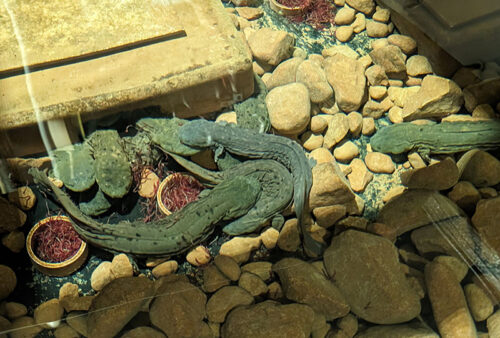 While NRCS accepts program applications year-round, Indiana producers and landowners should apply by May 10 to be considered for the current RCPP-Hellbender funding cycle. Applications received after May 10 will automatically be considered during the next funding cycle.
While NRCS accepts program applications year-round, Indiana producers and landowners should apply by May 10 to be considered for the current RCPP-Hellbender funding cycle. Applications received after May 10 will automatically be considered during the next funding cycle.
“The Farmers Helping Hellbenders RCPP project enables us to leverage partnerships to make a lasting positive impact on the habitat of the eastern hellbender salamander,” said Damarys Mortenson, state conservationist for the USDA’s NRCS in Indiana. “This project allows Indiana farmers and forestland owners to conserve the vital natural resources on their land while also protecting the habitat for hellbenders and other aquatic animals. It is a win-win.”
The eastern hellbender (Cryptobranchus alleganiensis alleganiensis) is a large, fully aquatic salamander, nicknamed the snot otter, water dog, devil dog, Allegheny alligator and water eel among other things. Their decline statewide has been documented as far back as the early-to-mid 1900s as a result of habitat loss and poor water quality. Hellbenders, which are listed as an endangered species in Indiana, play an important role in aquatic ecosystems and are indicators of clean water. Eastern hellbenders need clean water to survive as they breathe through their skin by absorbing oxygen from the river and stream water in which they live.
Hellbender populations are declining across their range, from Missouri to New York. This decline, which affects the hellbender population in Indiana’s Blue River, is likely caused by human influences such as habitat degradation and destruction. The stream-bottom habitat of hellbenders can be degraded by sediment from eroded banks and fields and destroyed when streams are dammed or dredged. Hellbenders are also captured inadvertently by anglers or purposefully for illegal sale in the pet trade. Finally, emerging diseases may be impacting some populations of hellbenders. Specifically, the chytrid fungus (Batrachochytrium dendrobatidis) and Ranavirus (family Iridoviridae) are considered to be major threats to the persistence of hellbender populations across their range.
For much of the last 17 years, Dr. Rod Williams and his team have been researching eastern hellbenders, spearheading regional conservation efforts and advancing hellbender captive propagation, or the rearing of this ancient animal in captivity and their eventual return to the wild. The partnership had a major breakthrough over the summer of 2023 with the documentation of a young hellbender salamander in the Blue River while conducting routine surveys. This discovery is significant because over the past three to four decades, only adult hellbenders have been documented in the Blue River. The presence of a young salamander suggests that conservation efforts and rearing programs are accomplishing their goals for the recovery of this endangered species.
The Farmers Helping Hellbenders RCPP project is made possible by $2.7 million in funding from the U.S. Department of Agriculture’s RCPP, Purdue and other partnering organizations. The project is led by Purdue with assistance from 14 collaborating public and private organizations on the state and local level including NRCS. The goal of the project is to improve hellbender habitat in a four-county region in south central Indiana by expanding the use of agricultural conservation practices that lead to decreased sediment in local river systems. The project aims to improve water quality, enhance aquatic habitat, increase aquatic wildlife populations, increase riparian and pollinator habitat and protect karst topography.
To view full article with more photos view Purdue Forestry and Natural Resources News & Stories: Farmers Helping Hellbenders RCPP Program Accepting Applications.
Resources:
USDA Awards Farmers Helping Hellbenders Project in Funding, Purdue Extension – Forestry and Natural Resources (FNR) Got Nature? Blog
Improving Water Quality by Protecting Sinkholes on Your Property, Purdue Extension – FNR YouTube Channel
Improving Water Quality Around Your Farm video, Purdue Extension – FNR YouTube Channel
Adaptations for Aquatic Amphibians, The Education Store, Purdue Extension’s resource center
Hellbenders Rock! Nature of Teaching Lesson Plan, The Education Store
Nature of Teaching – Hellbenders Rock Sneak Peek video, Purdue Extension – FNR YouTube Channel
Nature of Teaching – Hellbenders Rock webinar video, Purdue Extension – FNR YouTube Channel
Learn about hellbenders and take a tour of Purdue’s hellbender rearing facility video, Purdue Extension – FNR YouTube Channel
Learn about the hellbender work at Mesker Park Zoo video, Purdue FNR Facebook
Learn about hellbender work at The Wilds video, Purdue FNR Facebook
Dr. Rod Williams’ 2017 TEDx Talk Help the Hellbenders video, Purdue Extension – FNR YouTube Channel
A Moment in the Wild – Hellbender Hides video, Purdue Extension – FNR YouTube Channel
A Moment in the Wild – Hellbender Release video , Purdue Extension – FNR YouTube Channel
Wendy Mayer, FNR Communications Coordinator
Purdue University Department of Forestry and Natural Resources
Brian MacGowan, Purdue extension wildlife specialist, has been honored with the Hoosier Wildlife Award by the Indiana chapter of The Wildlife Society.
The Hoosier Wildlife Award is given annually to recognize an individual who has made, or is making, a significant contribution to professional wildlife conservation in Indiana through research, management, law enforcement, education or administration.
“The Hoosier Wildlife Award recognizes Brian’s substantial work in the field of wildlife conservation and his dedication to the Indiana Chapter of The Wildlife Society,” said Zachary Voyles, South Region Private Lands Supervisor for the Division of Fish and Wildlife. “His contributions to wildlife research, management and higher education have helped numerous wildlife management professionals become better equipped to manage wildlife in Indiana on behalf of its citizens.”
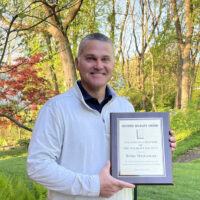 MacGowan came to Purdue in 1995 to begin work on his master’s degree in wildlife science under Dr. Harmon “Mickey” Weeks. His thesis was titled “Avian responses to woodland habitats differentially impacted by deer browsing.”
MacGowan came to Purdue in 1995 to begin work on his master’s degree in wildlife science under Dr. Harmon “Mickey” Weeks. His thesis was titled “Avian responses to woodland habitats differentially impacted by deer browsing.”
After completing his master’s in 1998, he joined the Purdue Extension staff as a wildlife specialist in 1999. He acted as extension co-coordinator for Purdue FNR from 2007 to 2015 and has served as the sole coordinator since 2015. MacGowan went on to complete his PhD on “Facilitating management and decision-making on private and public forests in Indiana” under Dr. Linda Prokopy in the spring of 2021.
In his time in FNR, he has been honored with the Outstanding Professional Staff Award twice (2005, 2010). He received the Purdue Cooperative Extension Specialists’ Association (PUCESA) Leadership Award in 2021 for his leadership and contribution to the development of FNR 506 course “Theory and Application of Natural Resources Extension Programming” and the creation of the Natural Resources Extension program.
During his career, MacGowan has conducted meaningful research, teaching, and extension programming that has advanced wildlife conservation in Indiana, the Midwest, and more broadly. His contributions include:
- Organizing over 180 workshops, seminars, and field tours related to wildlife conservation.
- Delivering over 400 Extension presentations and 60 research presentations and posters.
- Publishing 75 Extension publications, articles, videos, and book chapters.
- Publishing 14 peer-reviewed research publications.
MacGowan’s impressive portfolio spans a wide variety of topics from human-wildlife conflict, wildlife damage management, reptile response to forest management, youth natural resources education, and evaluating the impact of extension scholarship. He has been honored for his extension programs and deliverables throughout his career. He won the Agricultural Communications in Education Gold Award twice: for electronic publications “Snakes of the Midwest” in 2005 and for website “Everything Wildlife” in 2003. He also received the Association of Natural Resources Extension Professionals (ANREP) Gold Award for mixed materials “Wildlife CSI Unraveling the Mysteries of Wildlife Crop Damage” in 2007. He also earned the ANREP Silver Award for video/DVD/CD and for web-based courses for “Wildlife CSI Unraveling the Mysteries of Wildlife Crop Damage” in 2007.
MacGowan has been a member of the Indiana Woodland Steward Editorial Board since 2007, is the editor of the Indiana Woodland Steward newsletter and has served as the project investigator for the Renewable Resources Extension Act (RREA) in Indiana. He also organizes the yearly Ohio Valley Woodlands and Wildlife Workshop, conducts professional development workshops for the Natural Resources Conservation Service (NRCS) and other conservation partners and shares his knowledge at many extension events throughout the state.
MacGowan was instrumental in producing the Woodland Stewardship for Landowners video series. He also shared his knowledge on several editions of FNR Ask An Expert and provided instructional assistance regarding protecting plants and shrubs from wildlife, how to stop woodland animals from digging in your flowerpots, deer fencing, hummingbirds and more.
“I’m overwhelmed, especially knowing who has received this honor before me,” MacGowan said. “It’s one of the highlights of my professional career. Working at Purdue, and really in the wildlife profession, has put me in the position to work with some outstanding individuals. You hope that you have made a difference in people’s lives during your career. I got into the wildlife profession because I loved the outdoors. But, it’s the people you work with every day that makes it special. I’m extremely appreciative and humbled by this honor.”
Previous Purdue Forestry and Natural Resources affiliated winners of the Hoosier Wildlife Award include current or emeritus faculty members Dr. Rob Swihart (2016), Dr. Harmon “Mickey” Weeks (2006) and Dr. Russell E. Mumford (1996).
The Wildlife Society is a professional organization whose membership is comprised of professional wildlife biologists, managers, and scientists. The mission of The Wildlife Society is to inspire, empower, and enable wildlife professionals to sustain wildlife populations and habitats through science-based management and conservation. Members are committed to the conservation of natural resources in Indiana, including its soil, water, plants, and wildlife.
Article was shared from Purdue College of Agriculture News: Extension Specialist Brian MacGowan Receives Hoosier Wildlife Award.
Resources:
Agriculture Natural Resources (ANR) Newsletter Features Specialist Brian MacGowan, Purdue Extension – Forestry and Natural Resources (FNR) Got Nature? Blog
Wildlife, Playlist, Purdue Extension – FNR YouTube Channel
Ask the Expert: Birdwatching, Purdue Extension – FNR YouTube Channel
How to Stop Woodland Animals from Digging in Your Flower Pots, Got Nature? Blog with video, Purdue Extension FNR
Considerations for Trapping Nuisance Wildlife with Box Traps, The Education Store
Hardwood Ecosystem Experiment (HEE) – Wildlife Responses to Timber Harvesting, The Education Store
Snakes and Lizards of Indiana, The Education Store
Turtles of Indiana, The Education Store
Attracting Hummingbirds to Your Yard, The Education Store
Wendy Mayer, FNR Communications Coordinator
Purdue University Department of Forestry and Natural Resources

Recent Posts
- Cottonwood Seed Storm
Posted: May 31, 2024 in Forestry, Urban Forestry - Purdue Plant Doctor Website Equips Homeowners and Professionals
Posted: May 29, 2024 in Forestry, Forests and Street Trees, How To, Urban Forestry - Take Your Turkey Fun Further – Wild Bulletin
Posted: May 9, 2024 in Forestry, How To, Wildlife - Paddle for Data – Wild Bulletin
Posted: in Aquaculture/Fish, Great Lakes, Ponds, Wildlife - IISG Adds New Water Safety Videos
Posted: May 8, 2024 in Aquaculture/Fish, Aquatic/Aquaculture Resources, Community Development, Great Lakes, Wildlife - Invasive Bradford-Callery Pear: Why it is so detrimental and what to plant instead
Posted: in Forests and Street Trees, How To, Invasive Plant Species, Urban Forestry - Trees and Storms – Mitigating the Damage
Posted: May 7, 2024 in How To, Urban Forestry - New Indiana Woodland Steward Newsletter, Your Forest and Wildlife Resource
Posted: in Timber Marketing, Wildlife, Woodlands - Farmers Helping Hellbenders RCPP Program Accepting Applications
Posted: May 1, 2024 in Aquaculture/Fish, Forestry, How To, Wildlife, Woodlands - Extension Specialist Brian MacGowan Receives Hoosier Wildlife Award
Posted: in Forestry, Wildlife
Archives
Categories
- Alert
- Aquaculture/Fish
- Aquatic/Aquaculture Resources
- Ask the Expert
- Christmas Trees
- Community Development
- Disease
- Drought
- Forestry
- Forests and Street Trees
- Gardening
- Got Nature for Kids
- Great Lakes
- How To
- Invasive Animal Species
- Invasive Insects
- Invasive Plant Species
- Land Use
- Natural Resource Planning
- Nature of Teaching
- Plants
- Podcasts
- Ponds
- Publication
- Safety
- Timber Marketing
- Uncategorized
- Urban Forestry
- Webinar
- Wildlife
- Wood Products/Manufacturing
- Woodland Management Moment
- Woodlands